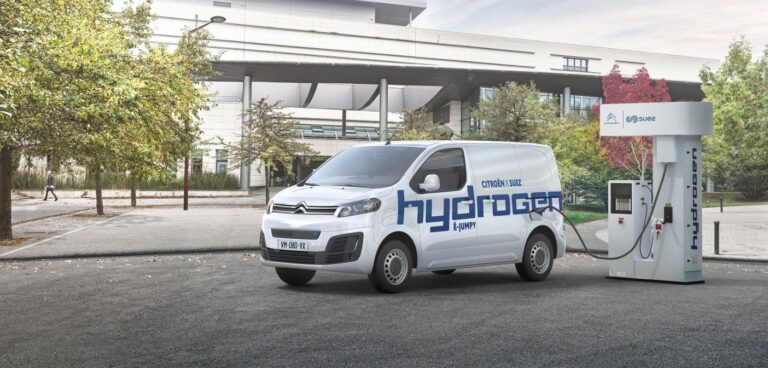French utility company Suez has conducted the first ‘real world’ trials of a hydrogen powered van, with the aim of highlighting the practical benefits of hydrogen.
The demonstrator, a Citroën ë-Jumpy Hydrogen, was used by a site foreman at a Carcassone location for daily activities including the restocking of small and large equipment supplies and emergency repair work in the event of a water leak. This involved regularly undertaking journeys of over 60 miles – which the project said can be achieved multiple times with ë-Jumpy Hydrogen’s 248-mile range.
Hydrogen technology allows for optimum practicality and wide-ranging usage requirements thanks to quick refuelling times that ensure vehicles are almost permanently operational, the partnership said. A complete refuel takes six minutes from a 350 bar pump, while stations fitted with a 700 bar pump can refill in half that time. The 10.5kWh battery – providing a 31-mile backup power supply if the hydrogen tanks run out – can be charged on a standard 230V socket.
The hydrogen technology combines a Lithium-ion battery with a fuel cell connected to hydrogen tanks. When hydrogen and air are brought into contact with a catalyst, the fuel cell generates electricity to power an electric motor. The only emission produced is water vapour. Compared to a battery, a fuel cell is considered more as an energy converter than a storage device.
This hybrid solution was chosen by Citroën following research conducted in partnership with Symbio, a joint venture specialising in fuel cells created by Michelin and Faurecia. Citroën ë-Jumpy Hydrogen benefits from both a 10.5kWh Lithium-ion battery and a 45kW fuel cell, powered by three 700 bar hydrogen tanks, developed by Faurecia, with a storage capacity of up to 4.4kg of hydrogen.
According to the collaboration, Hydrogen provides the energy needed for greater range, while the mid-capacity battery combines power and performance with energy recovery and recharging capability.
As this solution positions the battery pack under the seats at the front and the hydrogen tanks under the floor in the rear of the van, the modifications have no impact on the load volume of the vehicle. This system is also designed to ensure there is no compromise in performance, with a fuel cell powerful enough to guarantee constant speed on the motorway.
The battery then provides the energy required for acceleration and the extra power required when starting and for the first few miles on the road. Hybrid technology also means that the battery provides reserve power when the hydrogen tanks are empty, meaning drivers reduce the risks of ‘running dry’.
Furthermore, the load volume of ë-Jumpy Hydrogen is the same as for the standard Citroën Jumpy, with 5.3m3 for the Medium body style and 6.1m3 for the XL version. This also means a payload and towable load of up to 1 tonne on both versions, and a width between the wheel-arches of 1.25m.





